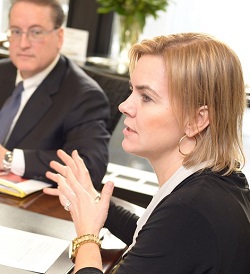Editor's note: In today's second installment of our three-part roundtable series on Canadian equity income, the portfolio managers discuss their overall strategies, given their assessments of current valuations and the market outlook. They then debate the merits of life insurers versus banks.
The panellists:
Michele Robitaille, managing director and equity-income specialist at Guardian Capital L.P., a sub-advisor to the BMO family of funds. The Guardian equity team's mandates include BMO Monthly High Income II.
Stephen Arpin, vice-president, Canadian equities at Beutel, Goodman & Co. Ltd. Arpin's responsibilities include Beutel Goodman Canadian Dividend and Beutel Goodman Small Cap.
Peter Frost, senior-vice-president and portfolio manager at AGF Investments Inc. His responsibilities include two income-oriented balanced funds: AGF Monthly High Income and AGF Traditional Income.
The roundtable was convened and moderated by Sonita Horvitch, whose series began on Monday and concludes on Friday.
Q: Let's talk about the valuation of the Canadian equity market.
Frost: The S&P/TSX Composite Index was trading at about 19.6 times trailing earnings at the end of 2017 versus 22.9 times at the end of 2016 and 20.3 times at the end of 2015. So, it is not more expensive than it was at the end of the prior two years on a trailing P/E basis. The same is true on a trailing price-to-cash-flow basis. This ratio in 2017 was a little lower than for the prior two years. The cash flows for some sectors have rebounded.
Robitaille: Valuations are pretty full across many sectors in the Canadian equity market. We see individual opportunities.
 |
|
 |
|
| Michele Robitaille | |
 |
|
 |
|
 |
Arpin: When you look across the market, valuations are high. As long as we have bond yields as low as they are, the equity market is well supported.
Q: What is your outlook for Canadian stocks?
Robitaille: We are cautious on the medium term. While there are a lot of positives in place, we are getting very late in the cycle. How does this relate to dividend stocks? Right now, there is a bit of a cyclical shift in the Canadian equity market. The conviction in that shift is not particularly high, so you will not see a full-scale shift out of the dividend sectors. If the turn in earnings starts to materialize, the market will move back into more defensive territory.
Frost: For the S&P/TSX Composite Index to do better in 2018, we need to see some material improvement in the energy pricing for Canadian producers.
Q: Time to discuss your style and process for your dividend/high-income funds.
Arpin: We are value managers. We look for high-quality businesses that are clearly undervalued versus our assessment of their intrinsic value. We focus on free cash flow. We look for a 50% total return over a three-year period. We require a minimum 1.5% dividend yield on the stock, when we first buy it. We sell one third of our holding in the stock when it reaches our initial target price and then reassess the stock. Beutel Goodman Canadian Dividend has a foreign content limit of 30% and we have been pretty close to that limit. It is split between the United States and international. We have 18 Canadian names out of a total 27 in this portfolio.
Frost: I have two balanced funds. They are AGF Traditional Income and AGF Monthly High Income. Currently, these funds have 64% in equities, 34% in fixed-income securities and 2% in cash. Traditional Income focuses on dividend growth for the equity component. We look at the track record of dividend growth, including the consistency of that growth. Monthly High Income focuses on the dividend yield. I screen for the highest yield. We have foreign content in both funds. In my stock selection for both funds, I focus on return on equity and return on invested capital. I like strong management ownership of the shares. We look for a two-year total return of 30%. I have 54 equity names in total in the Monthly High and 62 names in Traditional Income.
 |
|
 |
|
| Stephen Arpin | |
 |
|
 |
|
 |
Robitaille: We look for companies with stable, sustainable income and assess the ability of a company to grow its dividend over time. The yield on BMO Monthly High Income II is about 4.2%. We invest only in the top 75% of the Canadian dividend-yielding universe and our minimum yield is about 1.5%. We spend a lot of time meeting with management. We assess the health of the industry and the competitive positioning of the company. We look at a company's valuation relative to its historic trading range as well as relative to its specific peer group and relative to other parts of the portfolio. We do not have sell targets. We will trim around our core positions, if the stock is looking expensive. We have 37 names. It is a Canadian equity portfolio with no foreign content.
Q: Can we start the discussion on your portfolios by looking at the Canadian financial-services sector? This sector benefits from rising interest rates.
Frost: We prefer insurance companies versus the banks. We think that the former have higher earnings-growth prospects. The insurance companies benefit from rising bond yields. ![]() Manulife Financial Corp. (MFC) is a significant position. We like its operations in Asia. I also own
Manulife Financial Corp. (MFC) is a significant position. We like its operations in Asia. I also own ![]() Sun Life Financial Inc. (SLF). We think that Sun Life's investment-management operation is going to do better. We prefer the U.S. banks to the Canadian banks, as we think that there is going to be more loan growth south of the border. The only Canadian bank that I own is
Sun Life Financial Inc. (SLF). We think that Sun Life's investment-management operation is going to do better. We prefer the U.S. banks to the Canadian banks, as we think that there is going to be more loan growth south of the border. The only Canadian bank that I own is ![]() Bank of Nova Scotia (BNS). I like it for its operations in South America. It is an emerging-market growth story.
Bank of Nova Scotia (BNS). I like it for its operations in South America. It is an emerging-market growth story.
| Manulife Financial Corp. | Sun Life Financial Inc. | |
 |
||
| Jan. 29 close | $26.83 | $54.02 |
 |
||
| 52-week high/low | $27.77-$22.39 | $55.20-$43.51 |
 |
||
| Market cap | $52.9 billion | $32.6 billion |
 |
||
| Total % return 1Y* | 8.5 | 7.0 |
 |
||
| Total % return 3Y* | 11.5 | 14.4 |
 |
||
| Total % return 5Y* | 15.3 | 16.0 |
 |
||
 |
||
| *As of Jan. 29, 2018 Source: Morningstar |
||
Robitaille: The portfolio is market-weight financials relative to our benchmark, which is the S&P/TSX Composite High Dividend Index. We are slightly underweight the banks. They represent fair but not compelling value. Bank stocks had a nice run in the last three or four months of 2017. The banks are likely to produce solid earnings growth and dividend growth. We prefer those banks that have exposure outside Canada. For example, ![]() The Toronto-Dominion Bank (TD), which we own, will benefit from the stronger U.S. economy and from the tax reform.
The Toronto-Dominion Bank (TD), which we own, will benefit from the stronger U.S. economy and from the tax reform. ![]() Royal Bank of Canada (RY), another holding, will likewise benefit from this. We view TD, Royal and Bank of Nova Scotia as core holdings and our holding in
Royal Bank of Canada (RY), another holding, will likewise benefit from this. We view TD, Royal and Bank of Nova Scotia as core holdings and our holding in ![]() Canadian Imperial Bank of Commerce (CM) as more of a trading position. CIBC has been trading at a discount to the group and its historic trading range.
Canadian Imperial Bank of Commerce (CM) as more of a trading position. CIBC has been trading at a discount to the group and its historic trading range.
 |
|
 |
|
| Peter Frost | |
 |
|
 |
|
 |
Like Peter, we prefer the insurers to the banks. This is only a modest preference. The insurers' growth prospects are better and valuations are slightly more attractive. Manulife is our core holding. We also like the Asian growth story. Its wealth-management arm is doing quite well. Manulife has a new CEO. This will allow it to address the challenges it has in its legacy businesses, with a new set of eyes.
Arpin: Beutel Goodman Canadian Dividend has a significant weight in financials. We view financials as extremely high-quality businesses. During recessions, the Canadian banks tend to account for nearly all the earnings on the TSX. It is an oligopoly and the banks are low-cost providers. We do not view their valuations as being high. A rising interest-rate environment is a positive for financial institutions, more so for the insurers, but it is meaningful for the banks too. On the Canadian bank side, our big positions are TD, Royal, Bank of Nova Scotia and CIBC. We are looking for foreign exposure. Given, the high level of consumer indebtedness in Canada, the banks' domestic loan growth will probably be slower. Similar to Michele, we like CIBC because of valuation. It is good at gathering deposits, but a negative is that its home-mortgage business has grown faster than that of its peers.
On the insurance side, we own Sun Life and not Manulife. We like Sun Life. Its earnings have little adjustment to them. Its valuation is pretty attractive versus its peers. Manulife has some challenges.
Photos: Paul Lawrence Photography


















